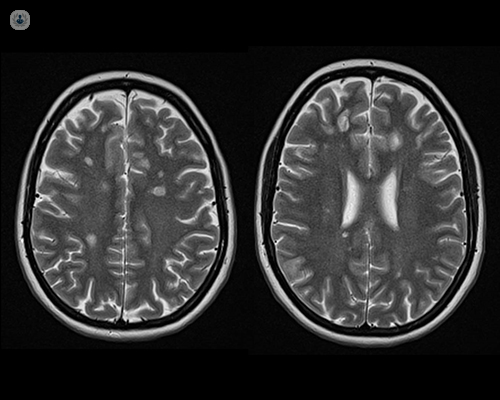What are the main symptoms of MS?
Escrito por:In this article below, esteemed consultant neurologist, Dr Omar Salim, provides us with an all-you-need-to-know guide with regards to multiple sclerosis.

What is multiple sclerosis?
Multiple sclerosis (MS) is a long-term condition that affects the central nervous system, which includes the brain and spinal cord. It is not known what exactly causes MS, but we know the immune system mistakenly attacks the protective covering (myelin) of nerve fibres. This attack leads to inflammation and damage, disrupting the communication between the brain and the rest of the body. As a result, MS can cause a wide range of symptoms that differ from person to person.
What are the main symptoms of MS?
MS symptoms can vary widely and may affect different parts of the body. These could present as relapses, where people would make full or incomplete recovery over a period of time with or without treatment with steroids, or present insidiously. Common symptoms include:
- Fatigue
- Walking and balance difficulties
- Visual problems
- Muscle weakness and spasms
- Numbness and tingling
- Cognitive difficulties
- Sphincter disturbance
Another main symptom of MS is what is known as the "MS hug", which refers to a symptom experienced by individuals with MS. It's a sensation of tightness or pressure around the chest or abdomen, similar to being hugged tightly. This sensation can be uncomfortable or even painful sometimes and is caused by spasms in the muscles between the ribs, which are often affected by MS.
What are the different types of MS?
There are several types of MS, each with different patterns of symptoms. The main types are:
- Relapsing-remitting MS (RRMS): This is the most common form, characterised by periods of new or worsening symptoms (relapses) followed by periods of partial or complete recovery (remissions). About 85 percent of people with MS are initially diagnosed with RRMS.
- Primary progressive MS (PPMS): This type involves a steady progression of symptoms from the onset, without early relapses or remissions. PPMS accounts for about 10 to 15 percent of MS cases.
- Secondary progressive MS (SPMS): This type may develop in people with RRMS however the incidence of this is in a downward trend given the availability of highly efficacious disease modifying therapies. In SPMS, symptoms gradually worsen over time, with or without relapses and remissions.
- Progressive-relapsing MS (PRMS): A rare form where individuals experience steadily worsening symptoms from the beginning with occasional relapses.
How is multiple sclerosis diagnosed?
Diagnosing MS can be challenging because its symptoms often resemble those of other conditions. The diagnosis process usually involves several steps:
- History taking
- Neurological examination
- MRI scans
- Lumbar puncture (spinal tap)
- Visual evoked potentials: These tests, though rarely used, measure the brain's electrical activity in response to visual stimuli to check for evidence of optic nerve dysfunction or optic neuropathy.
What are the most effective treatment options for MS?
Although there is no cure for multiple sclerosis (yet), there are multiple available highly efficacious disease-modifying therapy options for those eligible for treatment (i.e. with active multiple sclerosis), let alone other therapy options like physical exercise, supplements, and medications for symptomatic relief.
These treatments aim to manage symptoms, slow disease progression, and improve overall quality of life for individuals with MS. It's crucial for patients to work closely with their healthcare providers to determine the most suitable treatment plan based on their specific needs and disease activity. The following treatment options are highly effective:
- Highly efficacious treatments for RRMS: There are now highly effective disease-modifying therapies (DMTs) available for relapsing-remitting MS. These medications can significantly reduce the frequency and severity of relapses and slow down the progression of disability. Examples include monoclonal antibodies and other advanced therapies.
- Ocrelizumab for active primary progressive MS: Ocrelizumab is a treatment option specifically for active primary progressive MS. It works by targeting specific immune cells to reduce inflammation and slow disease progression.
- Siponimod for active secondary progressive MS: Siponimod is available for active secondary progressive MS. It helps manage the disease by modulating the immune system to prevent further damage to the central nervous system.
- Corticosteroids: can be used to treat acute relapses, if deemed appropriate, by reducing inflammation and speeding up recovery from attacks.
- Physical therapy: Customised exercise programmes that help maintain mobility and manage muscle stiffness and weakness, in particular aerobic exercises.
- Symptom management: Medications and other treatments to relieve specific symptoms like pain, bladder problems, and low mood.
To book an appointment with Dr Omar Salim today, visit his Top Doctors profile.


